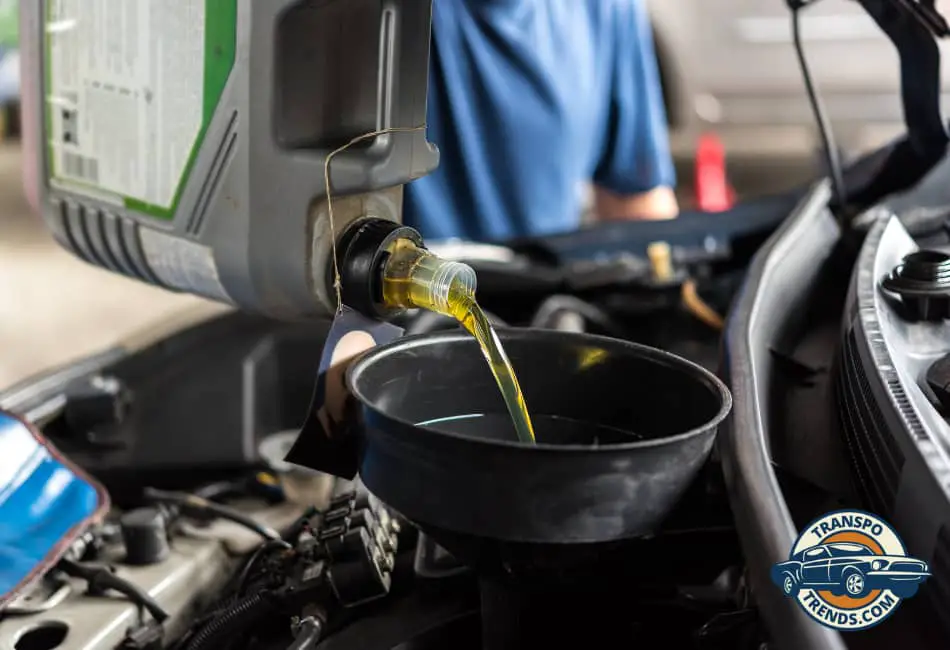Regular oil changes are a vital aspect of vehicle maintenance, playing a significant role in the longevity and performance of your engine.
However, there’s a long-standing debate among vehicle owners, technicians, and manufacturers alike about when exactly the oil should be replaced: Does a set timeline determine it, or should we be guided by the mileage clocked on the vehicle?
This blog post aims to dispel some of the confusion surrounding this subject. We’ll delve into topics such as the recommended oil change timelines, the evolution of mileage-based oil change recommendations, the ‘whatever comes first’ approach, how to check your oil, signs of degraded oil, the role of synthetic oil, and more.
By the end of this post, you’ll have a clearer understanding of the importance of regular oil changes and when to schedule them.
Why Are Oil Changes Necessary?
Motor oil serves multiple critical purposes in your vehicle’s engine. Here are the key roles that it performs and why regular oil changes are essential to maintain these functions:
- Cooling: One of the main functions of motor oil is to cool the engine by reducing friction and heat. The oil absorbs the heat produced by the engine’s moving parts, preventing overheating.
- Cleaning: Motor oil also serves a cleaning function. It carries away dirt, dust, and other contaminants that accumulate in the engine, ensuring it remains clean and operates efficiently.
- Lubrication: Motor oil provides essential lubrication to the engine’s moving parts. This lubrication reduces wear and tear, prolonging the engine components’ lifespan.
Over time, however, the quality of the motor oil degrades. The continuous heat, pressure, and contamination can cause the oil to lose its viscosity and ability to perform the abovementioned functions effectively.
Running your engine on low or degraded oil can lead to several problems, including:
- Reduced fuel efficiency
- Increased engine wear and tear
- Overheating of the engine
- Potential engine failure
This stresses the crucial necessity of regular oil changes to maintain your engine’s health and performance.
Maintenance Timelines
Adherence to the recommended maintenance timeline for oil changes, usually given by the vehicle’s manufacturer, is pivotal in maintaining the engine’s health.
Most car manufacturers suggest changing the oil approximately 2 to 3 times yearly, or every 7,500 to 10,000 miles, depending on the vehicle’s make, model, and use.
However, the timeline may vary for each vehicle. It is best to refer to your car’s owner’s manual or contact an automotive technician to get specific advice on when to change your oil.
It is also important to remember that the type of oil used should be in accordance with the manufacturer’s recommendations. If you are unsure, an expert can help you choose the right oil to ensure your engine works efficiently.
Manufacturer Recommendations
The exact frequency of oil changes can vary depending on the type of vehicle, the oil used, and the driving conditions.
Cars that often drive in harsh conditions may need more frequent oil changes. It is best to consult your car’s owner’s manual for the manufacturer’s recommended oil change schedule.
Adhering to these recommendations helps ensure your engine runs smoothly and efficiently over time.
Sticking to the prescribed oil change schedule is vital, regardless of the vehicle’s mileage. This is because oil degrades and loses effectiveness over time, even if the car is not being driven.
When oil degrades, it can’t perform its essential functions properly, leading to increased engine wear and tear, decreased fuel efficiency, and even potential engine failure.
Mileage-Based Recommendations
Traditionally, the recommendation was to change your oil every 3,000 miles. However, with advancements in oil technology and improvements in engine design, most modern cars can now go between 7,500 and 10,000 miles before needing an oil change.
This doesn’t mean you should ignore the 3,000-mile guideline entirely, especially if your vehicle is older or frequently driving under harsh conditions.
Following your vehicle manufacturer’s recommendations when planning your maintenance schedule is always best.
The “Whatever Comes First” Approach
The “Whatever Comes First” approach to oil change is a maintenance strategy that prioritizes regularity.
As the name implies, this approach suggests changing the vehicle’s oil based on either time or mileage, whichever comes first.
This method ensures that your vehicle gets the regular maintenance it needs. Whether you reach the recommended mileage first or the recommended time interval elapses, you proceed with the oil change, ensuring that your engine oil is always fresh and effective.
Defining the “Whatever Comes First” Approach
In basic terms, the “Whatever Comes First” approach is the practice of changing your car’s oil according to a set time interval or after a certain number of miles have been driven, whichever comes first.
For example, if your car manufacturer recommends an oil change every six months or every 7,500 miles, you would change the oil at six months even if you’ve only driven 4,000 miles.
Conversely, if you’ve driven 7,500 miles in just three months, you’d change the oil then without waiting for the six-month mark.
This strategy ensures that your car’s oil is always in good condition, protecting your engine and enhancing vehicle performance.
Importance of the “Whatever Comes First” Approach
The “Whatever Comes First” approach is an effective maintenance strategy because it ensures that your car’s oil is often changed enough to prevent oil degradation or contamination.
This approach can be particularly useful in certain scenarios. For instance, if you’re a city dweller who drives short distances and rarely puts many miles on your car, the time-based approach will ensure your oil is changed regularly, as short drives can contribute to faster oil degradation.
On the other hand, if you’re a long-distance commuter or frequently undertake long road trips, you’ll likely reach the mileage recommendation before the time interval, so the mileage-based approach comes into play.
Following this approach can maintain your vehicle’s health and longevity, ensuring a smoother, safer driving experience.
Checking Your Oil
Checking your oil regularly is a simple yet essential task that can greatly contribute to your vehicle’s long-term health and performance. Here’s how you can do it:
Step-by-Step Instructions
- Ensure the Engine is Cool: It’s important to allow your car to cool down before checking the oil. Hot oil may not give an accurate reading and could potentially cause harm.
- Locate the Dipstick: Open your car’s hood and locate the dipstick. If you’re unsure where it is, refer to your vehicle’s owner’s manual.
- Clean the Dipstick: Pull it out and clean it off completely with a lint-free rag. This step ensures you get an accurate reading.
- Check the Oil Level: Reinsert the dipstick fully, then pull it out again. Note the oil’s level on the dipstick. It should be between the two marks indicating the ideal oil level.
Understanding the Oil Level, Color, and Consistency
It’s crucial to check the oil’s level and observe its color and consistency. Fresh oil is typically amber in color and flows easily, while oil that needs changing may appear dark and thick.
If the oil is murky or has visible particles, it may indicate contamination and the need for an oil change.
Knowing how to interpret these signs can help you maintain the optimum performance of your car.
Paying attention to changing oil levels and colors should be a regular part of your routine vehicle maintenance.
Signs of Degraded Oil
Understanding the characteristics of your vehicle’s oil is crucial for maintaining its optimum performance. Fresh, high-quality motor oil possesses a few distinct attributes.
- Appearance of Fresh, High-Quality Motor Oil
Fresh motor oil is usually light or amber in color and has a clear appearance.
It flows smoothly and easily, serving as an effective lubricant that reduces friction between the moving parts inside your engine.
It also helps draw heat away from these components, preventing overheating.
How Degraded Oil May Appear
As motor oil ages and degrades, it undergoes changes in appearance and consistency. It may become darker, turning from amber to a black color.
Additionally, it may contain impurities such as tiny metal particles, dust, or other contaminants that have accumulated over time.
The oil might also become thicker and less smooth, inhibiting its ability to flow freely and do its job effectively.
Addressing Low or Deteriorated Oil Promptly
It is essential to address situations of low or deteriorated oil promptly. Ignoring these signs can lead to severe consequences, including engine damage.
Degraded or low oil levels can increase friction between engine components, leading to overheating and engine failure.
Regularly checking your oil level and changing it as needed can prevent these issues, prolonging the life of your vehicle and ensuring a smooth, worry-free ride.
Synthetic Oil and Extended Intervals
Synthetic oil represents a significant evolution in the field of automotive lubricants.
Engineered from a base of artificially created compounds, synthetic oils are designed to provide superior lubrication, protection, and cleaning compared to conventional oils.
The Impact of Synthetic Oil on Oil Change Intervals
One of the most notable benefits of synthetic oil is its potential to extend oil change intervals.
Where conventional oil might require changing after 3,000 to 5,000 miles, high-quality synthetic oils can potentially last between 10,000 to 15,000 miles under optimal conditions.
This is because synthetic oil is more resistant to breakdown, can withstand higher temperatures, and maintains its viscosity better over time than conventional oil.
Extended Mileage Intervals with Synthetic Oil
The extended mileage interval is a significant advantage of synthetic oil, as it can offer added convenience and potential cost savings over time for car owners.
The capability to drive longer distances between oil changes without compromising engine protection is a testament to the superior performance of synthetic oil.
Importance of Manufacturer Recommendations
Despite the impressive longevity of synthetic oil, it’s essential not to overlook your vehicle manufacturer’s recommendations for oil change intervals.
These guidelines are based on extensive research and testing and are designed specifically for your vehicle model’s optimum performance and longevity.
Ignoring these instructions could lead to premature wear or damage to the engine components.
So, regardless of the type of oil you use, always adhere to your manufacturer’s guidelines for the best vehicle maintenance.
Conclusion
To recap, synthetic oil represents a significant advancement in engine lubrication technology with its potential to extend oil change intervals, thereby adding convenience and cost savings for car owners.
Its enhanced resistance to breakdown, high-temperature performance, and viscosity maintenance demonstrate its superior performance over conventional oil.
However, it’s important to remember that regular oil changes are crucial to maintaining engine health, regardless of the type of oil you choose.
Manufacturer recommendations should always be the baseline for your vehicle’s maintenance schedule, given they are tailored to your specific model’s needs based on extensive research and testing.
Remember, it’s always best to consult trusted technicians for personalized advice to ensure your vehicle’s longevity and optimal performance.
The type of oil you use is a decision that should be made carefully, considering both the product’s capabilities and your vehicle’s unique requirements.

